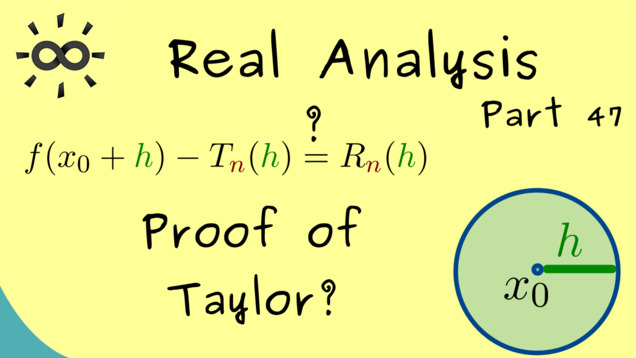
-
Title: Proof of Taylor’s Theorem
-
Series: Real Analysis
-
Chapter: Differentiable Functions
-
YouTube-Title: Real Analysis 47 | Proof of Taylor’s Theorem
-
Bright video: https://youtu.be/oZZrwKsqVro
-
Dark video: https://youtu.be/f9w9T29Xgdk
-
Ad-free video: Watch Vimeo video
-
Quiz: Test your knowledge
-
Dark-PDF: Download PDF version of the dark video
-
Print-PDF: Download printable PDF version
-
Exercise Download PDF sheets
-
Thumbnail (bright): Download PNG
-
Thumbnail (dark): Download PNG
-
Subtitle on GitHub: ra47_sub_eng.srt missing
-
Timestamps (n/a)
-
Subtitle in English (n/a)
-
Quiz Content
Q1: Which theorem do we use in the proof of Taylor’s theorem?
A1: Intermediate value theorem
A2: Generalised mean value theorem
A3: L’Hospital’s theorem
A4: Sandwich theorem
Q2: In the proof, we use a telescoping argument for sums. What is the value of the following sum? $$ \sum_{j=1}^n (a_j - a_{j-1})$$
A1: $a_n$
A2: $a_0$
A3: $a_n - a_0$
A4: $a_n - a_{n-1}$
A5: $1$
A6: $-a_n + a_0$
Q3: In the proof, we calculated $f(x_0) - T_n(h)$. What did we get?
A1: $h^{n} \frac{f^{(n+1)}(\xi)}{(n+1)!}$
A2: $h^{n+1} \frac{f^{(n+1)}(\xi)}{(n+1)!}$
A3: $h^{n} \frac{f^{(n)}(\xi)}{n!}$
A4: $h^{n+1} \frac{f^{(n)}(\xi)}{(n+1)!}$
-
Last update: 2025-01